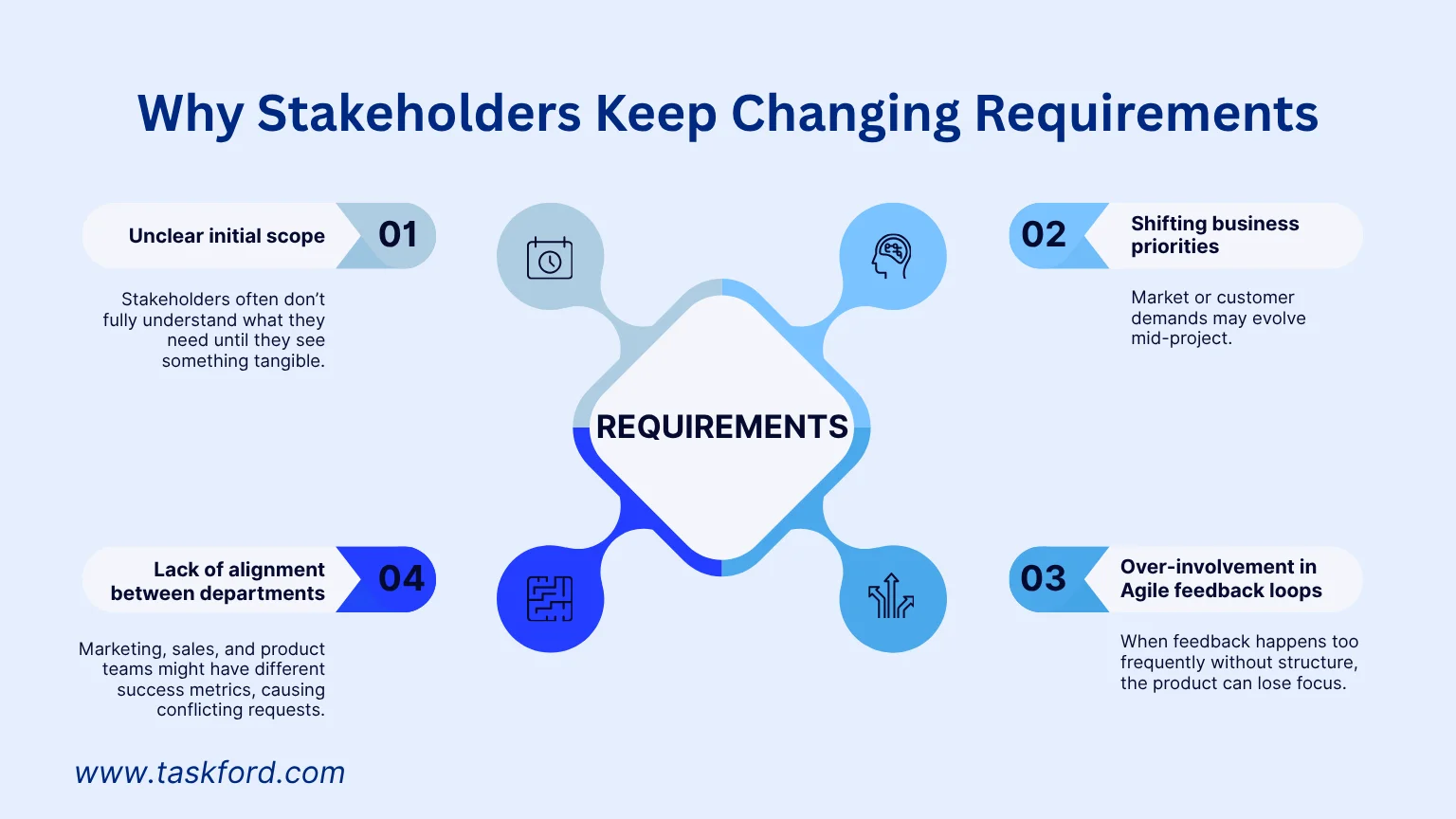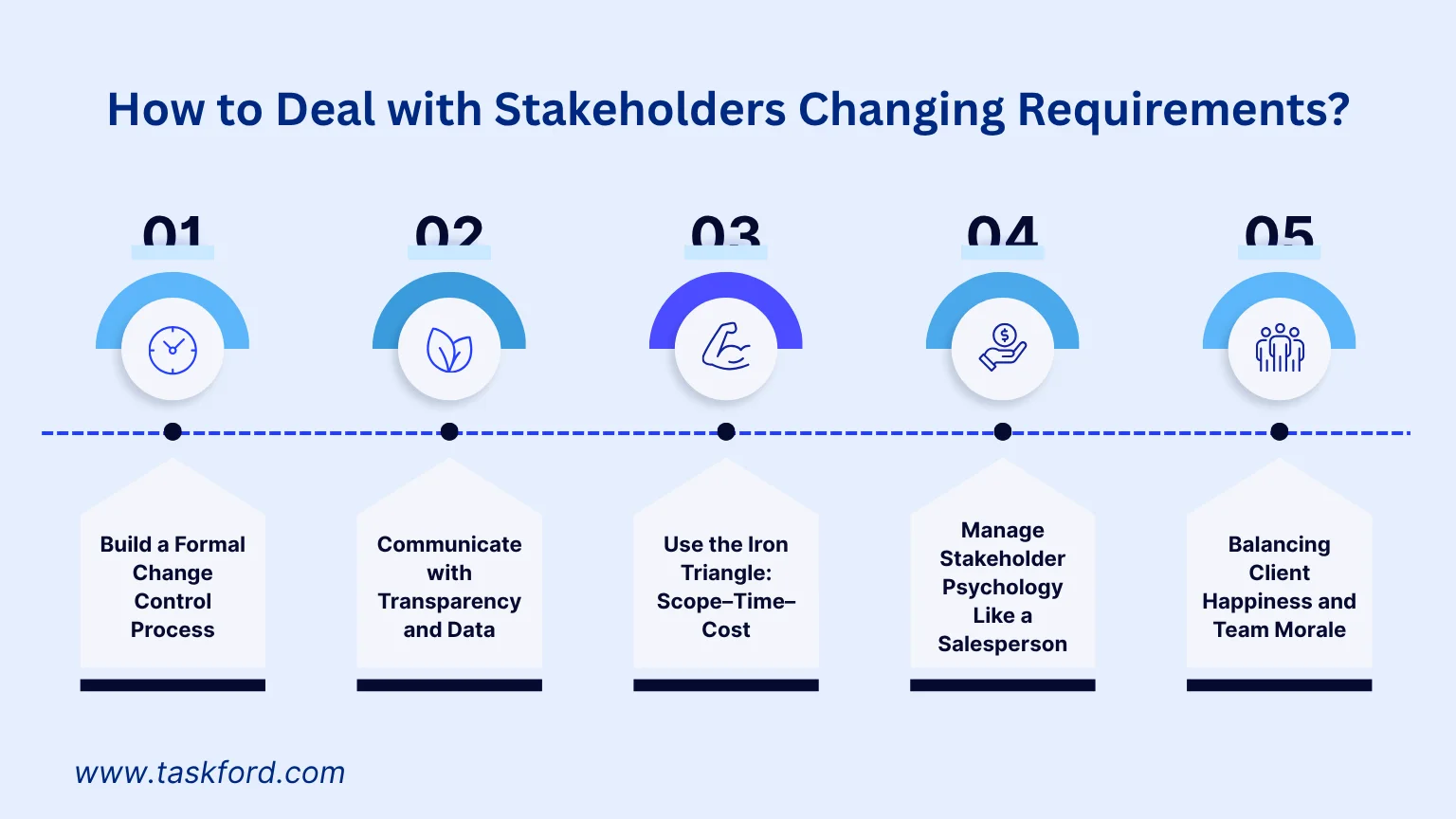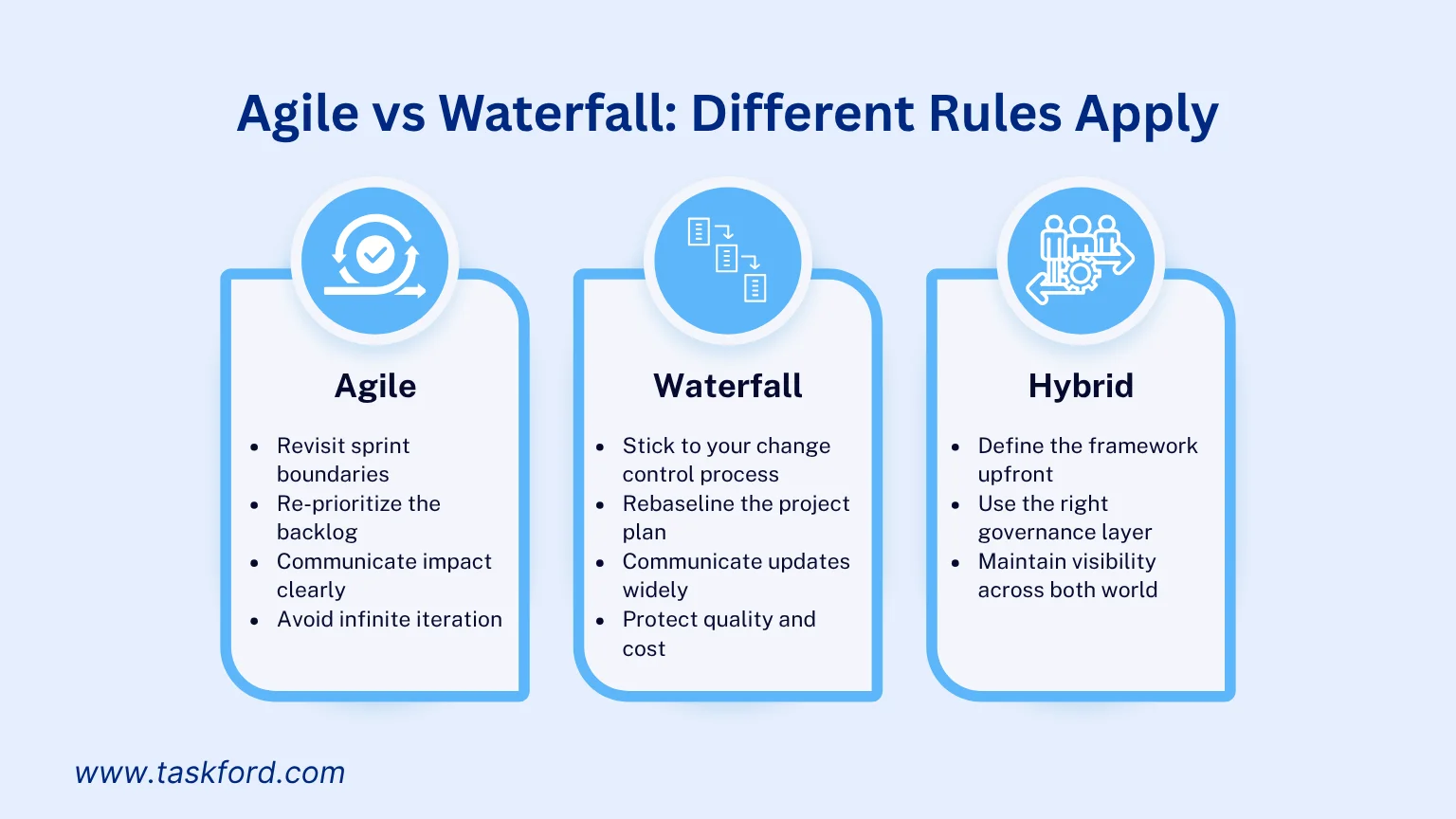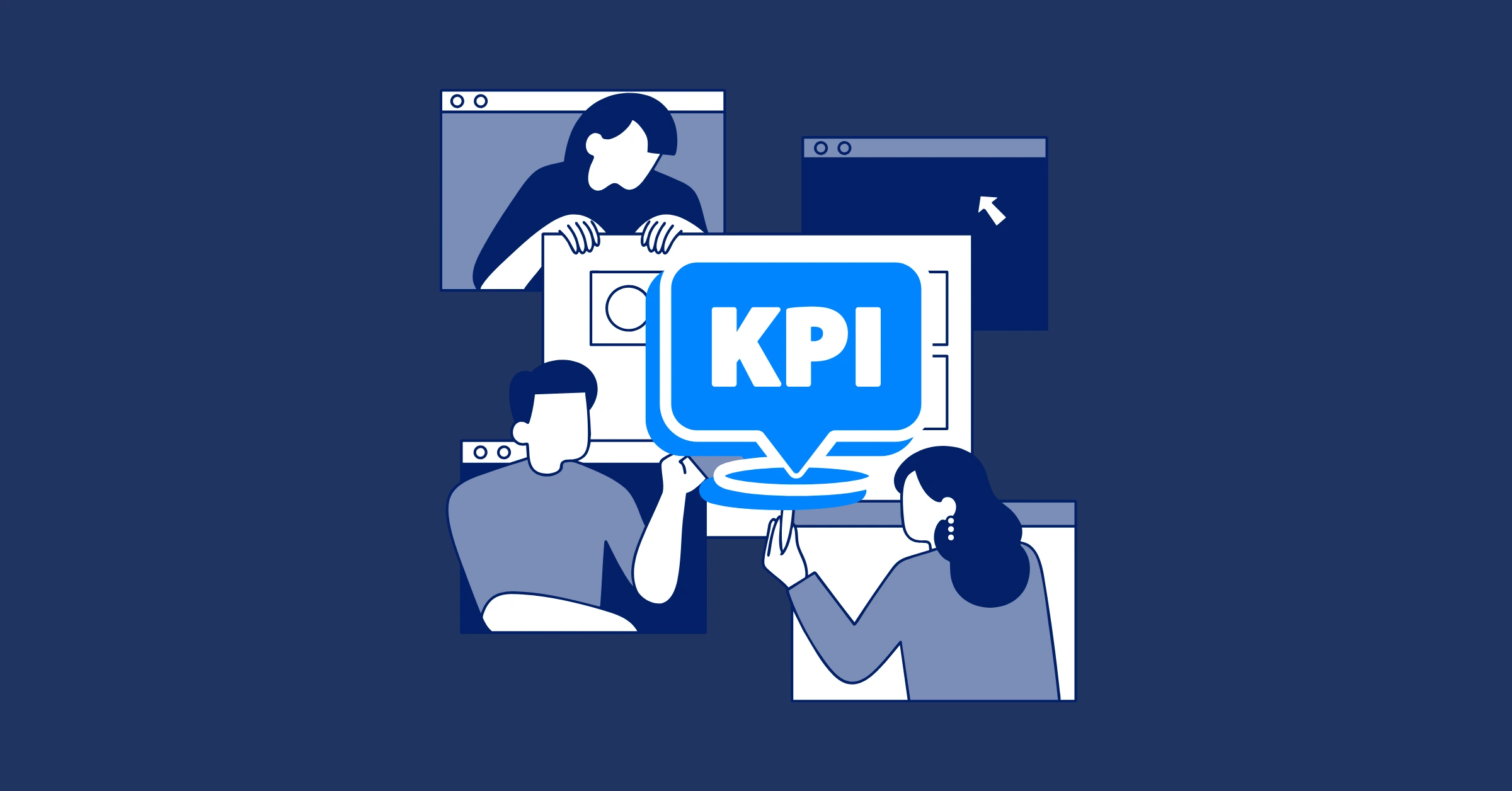How to Deal with Stakeholders Changing Requirements Mid-Project
Discover proven strategies to dealing with stakeholder change requirements, and stay in control, even when project goals shift.
Few things frustrate project managers more than this: you’ve just wrapped up a successful sprint review, and then - bam - a key stakeholder decides to change the scope again. Suddenly, your neat project plan is a tangled mess of new priorities, delayed deadlines, and exhausted teammates.
Sound familiar? You’re not alone.
In every industry, from software to construction, scope change is one of the most persistent threats to delivery and morale. The truth is, stakeholder needs will evolve, but if you manage these changes properly, you can protect both your timeline and your sanity.
This guide walks you through practical, battle-tested strategies for dealing with stakeholder change requirements, so you can stay in control, even when the goalposts move.
If you’re new to the field, you can start with our guide on What is Project Management to get a clear understanding of the basics and methodologies.
Why Stakeholders Keep Changing Requirements

Before you can fix the problem, it helps to understand why it happens.
- Unclear initial scope: Stakeholders often don’t fully understand what they need until they see something tangible.
- Shifting business priorities: Market or customer demands may evolve mid-project.
- Over-involvement in Agile feedback loops: When feedback happens too frequently without structure, the product can lose focus.
- Lack of alignment between departments: Marketing, sales, and product teams might have different success metrics, causing conflicting requests.
Understanding the “why” helps you respond with empathy, not frustration, and positions you to steer the conversation toward solutions instead of conflict.
Recognize the Real Impact of Mid-Project Changes
Every change, no matter how small, creates ripples that spread through your entire project. It might look simple on paper, but in reality, even “minor tweaks” can accumulate into serious disruptions.
Here’s what happens when you say “yes” too easily:
- Timelines stretch: A small adjustment to one feature often triggers new design reviews, development work, and testing. Those extra days quickly add up, especially when multiple stakeholders keep adding requests after every sprint.
- Costs increase: Extra work means more hours, more coordination, and sometimes new dependencies or licenses. Without clear change tracking, it’s easy to lose sight of where the budget went.
- Team morale dips: When priorities constantly shift, the team can feel like they’re building on sand. Developers and designers start to feel frustrated, questioning whether their work will ever be “final.” Over time, this uncertainty leads to burnout.
- Quality and focus suffer: Constant context switching increases the risk of defects and technical debt. When a team rushes to meet moving targets, quality becomes the first casualty.
That’s why experienced project managers insist on formal impact assessments for every change. It’s not about blocking flexibility, it’s about making the cost of change visible to everyone involved.
How to Deal with Stakeholders Changing Requirements Mid-Project?
Dealing with stakeholders who change requirements mid-project requires a careful balance of structure, communication, and adaptability. Here’s a step-by-step approach to help you manage change effectively, without losing control of your project.

1. Build a Formal Change Control Process
The most effective way to protect your project is to make every change official. A Change Control Process ensures that any modification is evaluated, approved, and documented before work begins.
Step-by-step process:
- Capture the change request: Use a standardized form to record who requested the change, when, and why.
- Perform an impact assessment: Analyze how the change affects the project’s time, cost, scope, and resources.
- Review and approve: Present the findings to a Change Review Board (CRB) or Steering Committee (SteerCo) for a go/no-go decision.
- Rebaseline if approved: Update the project plan, budget, and documentation accordingly.
- Communicate the outcome: Whether approved or declined, make sure the team and stakeholders understand the rationale.
This structure gives you something invaluable - transparency. Everyone knows what was requested, what it costs, and who approved it. It’s not just bureaucracy; it’s protection for your team and your reputation.
2. Communicate with Transparency and Data
Frequent scope changes often come from miscommunication or a lack of visibility. To counter that, always:
- Keep written records of meetings, decisions, and approvals.
- Use dashboards to show project progress, change requests, and their impacts.
- Clearly highlight trade-offs; if a new feature is added, which one gets deprioritized?
Transparent communication not only prevents blame games but also builds trust. When everyone sees the data, decisions become easier to justify.
3. Use the Iron Triangle: Scope–Time–Cost
Every project manager knows the Iron Triangle (also called the Triple Constraint): Scope, Time, and Cost — you can only fix two.
If the stakeholder wants to increase the scope, you must adjust either the timeline or the budget. There’s no magic formula that allows all three to stay constant.
When a client asks for “just one more feature,” respond with:
- “Sure, we can do that. It’ll take an extra two weeks.”
- or “Sure, but that will add $8,000 to the budget.”
The key is to frame it as a choice, not resistance. This approach makes stakeholders co-owners of the decision rather than adversaries.
4. Manage Stakeholder Psychology Like a Salesperson
Successful project management is part process, part persuasion.
- Respond positively first: “Yes, we can do that…” before explaining the impact. This keeps conversations collaborative.
- Quantify everything: Assign a cost or time impact to every change. Numbers cut through opinions.
- Control the narrative: If the change is “dumb,” exaggerate the effort needed (within reason). Often, stakeholders will back off once they see the true cost.
- Educate gently: Many stakeholders don’t understand scope discipline—your job is to guide them, not shame them.
Managing stakeholder psychology is about balancing flexibility with firmness, the art of saying yes, but.
5. Balancing Client Happiness and Team Morale
When requirements keep changing, your team feels it first. They may lose motivation, feel overworked, or stop trusting leadership. As the project manager, you need to protect them while maintaining professionalism with the client.
- Explain the “why”: Let the team understand the business context behind the change.
- Shield them from chaos: Don’t pass every stakeholder whim directly to the developers or engineers.
- Celebrate progress: Acknowledge the team’s adaptability and patience.
- Be their advocate: If changes are unreasonable, escalate diplomatically.
Sometimes, yes, you can’t say no, especially if the client is strategically important. In those cases, focus on morale management and realistic expectations. Other times, saying “no” respectfully can preserve both your team and your credibility.
Agile vs Waterfall: Different Rules Apply When Dealing with Stakeholders Changing Requirements
Not all change is bad, especially when your team operates in an Agile environment.
Agile projects are built around flexibility, constant feedback, and iterative delivery. On the other hand, Waterfall projects rely on structure, predictability, and strict documentation. Both can handle change, but the rules are very different.
Learn more: Agile Project Management vs Waterfall: What's The Difference?

If You’re Working in Agile
Change is part of the DNA of Agile, it’s even written in the Agile Manifesto: “Responding to change over following a plan.”
However, “responding” doesn’t mean “accepting everything at any time.” Agile teams should embrace change strategically, not chaotically. Here’s how to handle mid-project requirement shifts effectively:
- Revisit sprint boundaries: If a significant change comes mid-sprint, don’t try to squeeze it in. Instead, end the sprint early, hold a quick retrospective, and start a new sprint planning session. This ensures the backlog stays organized and team focus is protected.
- Re-prioritize the backlog: Product Owners (POs) play a critical role here. When new requirements appear, they must evaluate their value against existing stories and re-order priorities. The goal isn’t to do everything, it’s to do the right things first.
- Communicate impact clearly: Let stakeholders know what will be delayed or dropped due to the new request. Saying “Yes, but that means feature X will move to Sprint 6” keeps expectations realistic.
- Avoid infinite iteration: Agile thrives on adaptability, but constant direction changes destroy momentum. Maintain a “stability window” — for example, commit to finishing the current sprint before implementing new feedback unless it’s critical.
With a disciplined Product Owner and transparent communication, Agile teams can absorb change without losing speed or morale.
If You’re Working in Waterfall
Waterfall follows a linear sequence — plan, design, build, test, deliver. Once development begins, scope changes become exponentially more expensive. That’s why in Waterfall, formal control is essential.
To manage change effectively:
- Stick to your change control process: Every change request must go through impact assessment, approval, and documentation before work begins.
- Rebaseline the project plan: When a change is approved, update your schedule, budget, and scope documents to reflect the new baseline. This ensures everyone knows what “success” now looks like.
- Communicate updates widely: Share revised milestones and responsibilities with all stakeholders. Surprises are the enemy of trust in a Waterfall project.
- Protect quality and cost: Don’t cut corners to squeeze in late changes. If stakeholders insist, use the Iron Triangle logic: scope increases mean either time or cost must increase too.
Waterfall projects succeed when discipline outweighs improvisation. Clarity and documentation are your strongest allies here.
If You’re Working in a Hybrid Environment
Many organizations today operate in a hybrid model, combining Agile sprints with traditional project oversight. While it sounds ideal, this mix can easily become messy if boundaries aren’t clear.
Here’s how to make it work:
- Define the framework upfront: Decide early which elements follow Agile (e.g., sprint development, backlog refinement) and which follow Waterfall (e.g., approvals, reporting, compliance). Without this clarity, you’ll end up with a “Frankenstein process” that confuses everyone.
- Use the right governance layer: Establish a lightweight change control process that aligns with Agile values but still satisfies Waterfall governance. For example, small user story adjustments can be approved by the Product Owner, while larger scope changes need steering committee review.
- Maintain visibility across both worlds: Use project management tools to centralize Agile boards and formal approval workflows in one dashboard, ensuring changes are transparent whether you’re sprinting or reporting to executives.
Hybrid models can deliver the best of both systems — but only if rules are well-defined and consistently applied.
Final Thoughts
Change is inevitable, in business, in technology, and especially in projects that involve multiple stakeholders with evolving goals. The problem isn’t that requirements change; it’s that they often change without structure or visibility.
The best project managers don’t try to resist change - they manage it. They build clear processes, document every decision, and communicate with data instead of emotion. They know when to say “yes,” when to say “not now,” and how to turn difficult conversations into collaborative problem-solving.
Whether you’re working in Agile, Waterfall, or a Hybrid environment, the formula stays the same:
- Formalize change control
- Communicate transparently
- Balance client satisfaction with team well-being
- Keep your scope, cost, and time in alignment
Handled correctly, stakeholder changes can actually strengthen your project, refining the final product and building long-term trust. Handled poorly, they can derail even the most promising plan.
So next time a stakeholder shifts direction mid-project, take a breath, pull up your change log, and guide the discussion with clarity and confidence. With the right framework and mindset, you’re not just reacting to change - you’re mastering it.
Making work simpler,
smarter, and more connected
Join our waitlist and be notified first.

Subscribe for Expert Tips
Unlock expert insights and stay ahead with TaskFord. Sign up now to receive valuable tips, strategies, and updates directly in your inbox.






